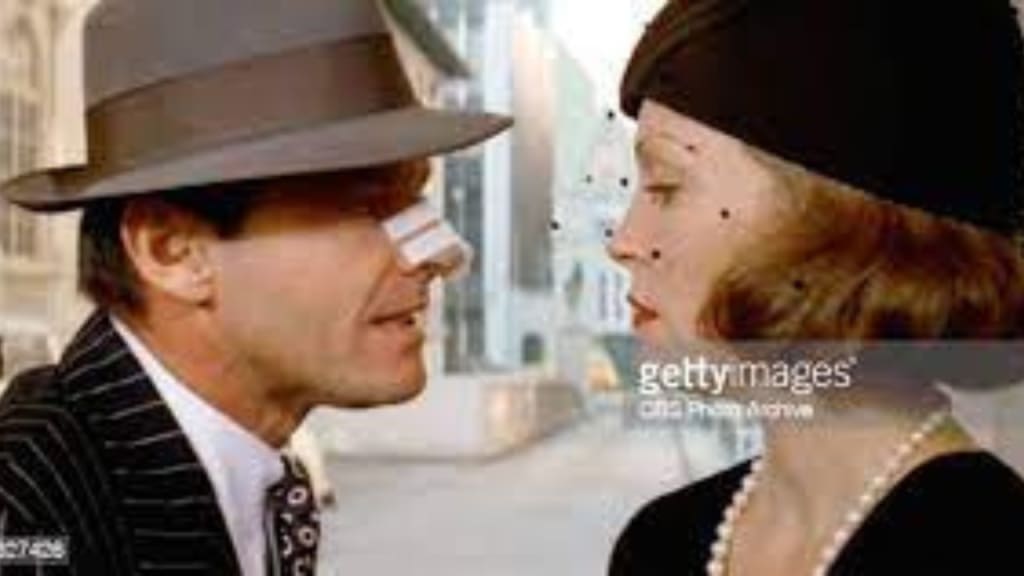Chinatown (1974) Review
1974 American neo-noir mystery film directed by Roman Polanski

Chinatown is a classic neo-noir film directed by Roman Polanski and released in 1974. It stars Jack Nicholson as private detective J.J. "Jake" Gittes and Faye Dunaway as Evelyn Mulwray, the wife of a Los Angeles water department official who becomes embroiled in a complex and dangerous web of corruption and deceit.
The movie is set in 1937 Los Angeles, a city on the brink of massive expansion and development. Gittes is a former cop turned private investigator who specializes in exposing cheating spouses. He is hired by a woman claiming to be Evelyn Mulwray to investigate her husband's alleged affair with a young girl. Gittes takes on the case but soon finds himself drawn into a much larger and more dangerous conspiracy involving water rights and political corruption.
One of the strengths of Chinatown is the fantastic performance of Jack Nicholson as Jake Gittes. Nicholson brings a level of cynicism and world-weariness to the character that perfectly fits the film's noir atmosphere. Gittes is a flawed hero, a man with a troubled past and a jaded view of the world, but he is also a tenacious and determined investigator who is unwilling to give up even when the odds are against him.
Faye Dunaway also delivers a strong performance as Evelyn Mulwray, a woman with a dark and tragic past who is struggling to protect her family and her secrets. Dunaway brings a level of vulnerability and complexity to the character that makes her both sympathetic and enigmatic. The chemistry between Nicholson and Dunaway is electric, with their interactions crackling with tension and sexual tension.
The supporting cast is also excellent, with strong performances from John Huston as the wealthy and powerful Noah Cross, and John Hillerman as the smooth and calculating water department official, Yelburton. The ensemble cast is rounded out by a number of memorable character actors, including Burt Young, Perry Lopez, and Diane Ladd.
The cinematography in Chinatown is stunning, with the film's cinematographer, John A. Alonzo, creating a moody and atmospheric look that perfectly captures the film's noir style. The use of shadow and light, the contrast of bright, sun-drenched exteriors with dark, shadowy interiors, all contribute to the film's sense of mystery and danger.
The film's screenplay, written by Robert Towne, is also a standout. The script is filled with sharp dialogue, memorable one-liners, and twists and turns that keep the audience guessing until the very end. The film's themes of corruption, greed, and the abuse of power are as relevant today as they were when the film was released, making it a timeless classic.
The film's climax, set in the eponymous Chinatown, is a masterclass in tension and suspense. The scene builds to a shocking and tragic conclusion that is both heartbreaking and inevitable. The film's final shot, with Gittes standing alone in the deserted street, is a powerful and haunting image that lingers long after the credits have rolled.
The film was inspired by the California Water Wars of the early 20th century, which saw a number of powerful individuals and corporations jockeying for control of the state's water supply. The character of Hollis Mulwray, the chief engineer of the Los Angeles Department of Water and Power, is based on William Mulholland, the real-life engineer who oversaw the construction of the Los Angeles Aqueduct and was a central figure in the water wars.
Roman Polanski, who directed the film, had a cameo appearance in the movie as the thug who cuts Gittes' nose with a switchblade. This scene is one of the film's most memorable and shocking moments.
The film's title, Chinatown, refers to a section of Los Angeles where Chinese immigrants were concentrated in the early 20th century. The area was known for its crime, poverty, and political corruption, and it serves as a symbolic backdrop for the film's climactic scene.
The film was a critical and commercial success upon its release, earning 11 Academy Award nominations and winning one for Best Original Screenplay (written by Robert Towne). However, it lost the Best Picture award to The Godfather Part II.
The film's score, composed by Jerry Goldsmith, is notable for its use of a solo trumpet as its main instrument. The trumpet's mournful, melancholic sound adds to the film's overall sense of sadness and tragedy.
The film's plot is notoriously complex and difficult to follow, with numerous twists and turns that can be confusing for viewers. However, this complexity is also one of the film's strengths, as it rewards careful attention and multiple viewings.
In addition to its noir elements, the film also contains elements of the Western genre, with its depiction of the lawless, frontier-like atmosphere of Los Angeles in the 1930s.
The film's production was not without its controversies. Faye Dunaway reportedly clashed with director Roman Polanski over the film's script and her character's motivations, while Jack Nicholson was nearly fired from the film due to concerns about his performance.
In conclusion, Chinatown is a masterpiece of American cinema, a classic neo-noir film that stands the test of time. It is a film that rewards repeat viewings, with its complex characters, intricate plot, and stunning visuals. It is a must-see for anyone interested in the history of cinema, and a film that will continue to captivate and enthrall audiences for generations to come.





Comments
There are no comments for this story
Be the first to respond and start the conversation.